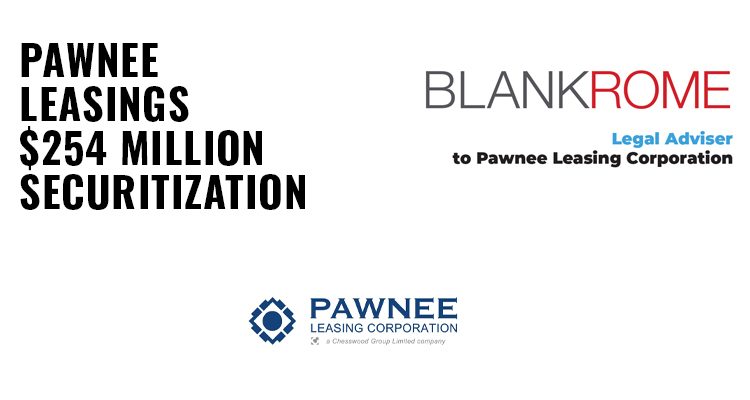Pawnee Leasing’s $254 Million Securitization
Pawnee Leasing Corporation closed its first marketed U.S. securitization on 8 October 2019, which contained Pawnee’s prime commercial equipment receivables.
Proceeds from the $254 million securitization were used to pay down Pawnee’s revolving warehouse line and to reduce the outstanding balance of Pawnee’s parent company, Chesswood Group Limited’s, senior revolving credit facility.
Pawnee Leasing Corporation is an equipment leasing company that was founded in 1982 and conducts business in all of the lower 48 states of America. It specialises in providing business equipment leases for equipment financing through an independent network of lease brokers.
Blank Rome LLP represented Pawnee Leasing Corporation in closing its issuance. The team consisted of Steve Whelan, Grant Buerstetta, Jeff Gimpel, John Louros, and Delaram Peimani.
An interview with Steve Whelan at Blank Rome LLP
What was unusual about this transaction?
This transaction was the culmination of an amazing process during which Pawnee closed five securitized financings in a 24-month period. The first two transactions were term loans in a securitized format, the next two were warehouse lines of credit, and finally, the $254 million deal which closed in October 2019, a rated, term securitization. I have been handling equipment finance securitizations since 1985 and seldom have seen an issuer accomplish this complete cycle of transaction format so quickly with efficient execution at each step.
Is the process you undergo different when asset-backed securities are collateralised by equipment leases and loans?
Equipment ABS transactions present additional issues that are not present in, for example, securitizing auto loans. Issuers such as Pawnee many times rely on third parties to originate the leases or loans; the third parties sell those contracts to a financial institution such as Pawnee, which has much better access to advantageous financing than the originators may enjoy. In other securitization markets, many originators sell financial assets directly into the securitization structure rather than relying on an intermediary, such as Pawnee in the equipment market. For equipment loans and larger value leases, it is customary for Pawnee or other originators to file UCC financing statements against the underlying obligor(s), and discussion invariably focuses on the dollar value of the equipment as the threshold for making these filings.
How did you ensure that this decision was the best for all parties?
The decision to perform a term securitization was a business decision made by Pawnee and its investment bankers. When Pawnee closed its revolving warehouse line of credit in August 2018 with RBC, that facility was structured in anticipation that one or more term securitizations would occur. So the documents were written to provide Pawnee with the flexibility to transfer assets from the special purpose entity (that was the borrower under the warehouse) to another SPE which would be the issuer of the term ABS. Some of the 2018 documents were readily adaptable for use in the 2019 term deal. In retrospect, the best decision was to push for a closing early in the fourth quarter of 2019 rather than waiting for early 2020. We all know what the credit markets have been like in 2020!
What issues did you and your team navigate to overcome?
Many of the documentary issues were anticipated during the creation of the 2018 warehouse facility, but others had to be addressed in 2019. One significant issue was demonstrating how Pawnee complied with the risk retention regulations promulgated by the Securities and Exchange Commission and other federal agencies. This not only required the documents to contain appropriate covenants, but also necessitated the financial advisers to structure the credit enhancement to meet or exceed the minimum risk retention amount required by the Dodd-Frank Act and related regulations.




